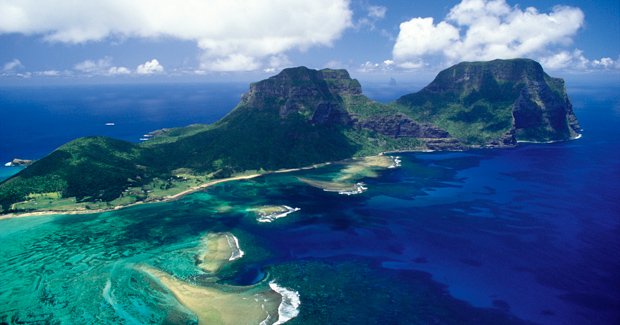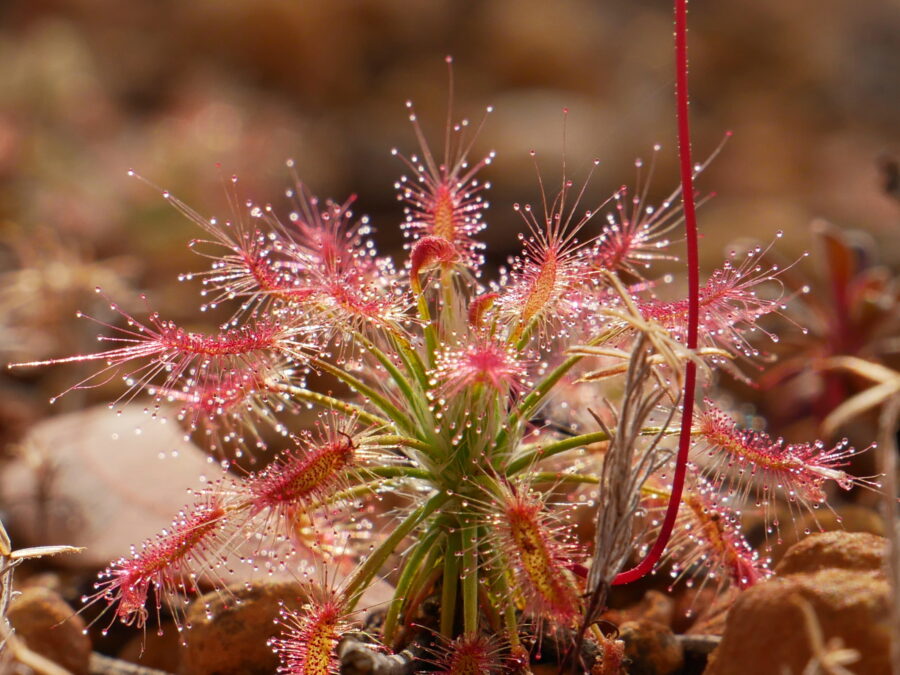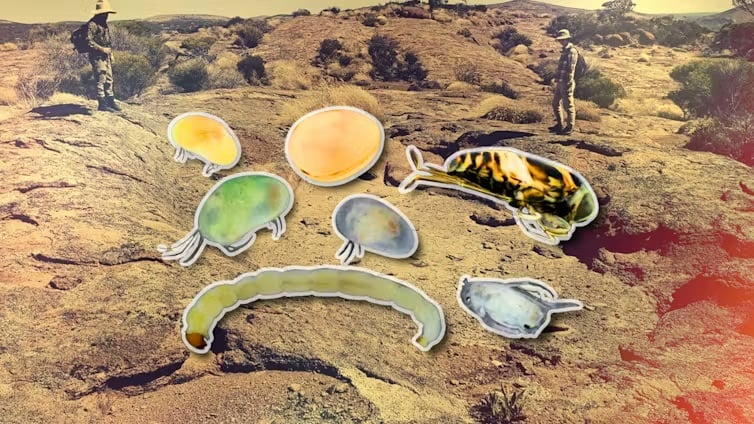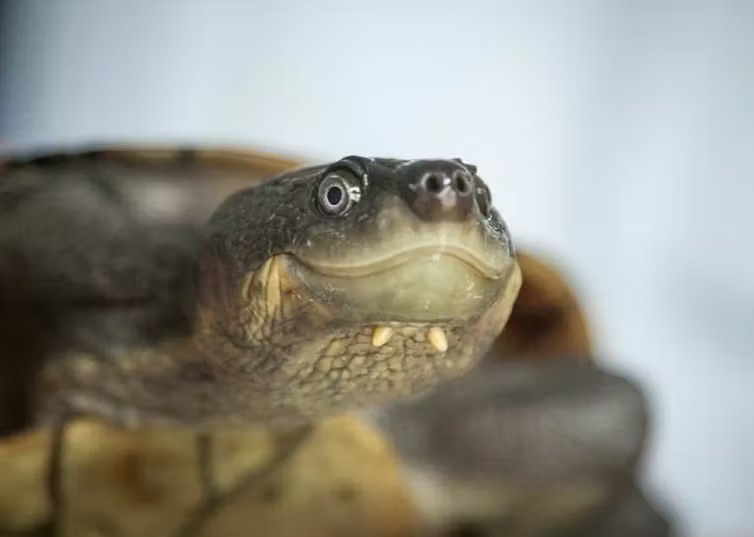Island nation: Australia’s 8222 islands

PERCHED ON A CLIFF by the water’s edge, I watch the commuter traffic stream overhead. It’s early evening on Christmas Island, 1800km north-west of mainland Australia, and the boobies are returning from their shift at sea. Hundreds upon hundreds of these big bony birds pass by, so close at times I could almost touch them if I tried.
There are the larger frigatebirds as well, sweeping by on black, scythe-like wings, and noddies, much smaller and flapping faster as if in haste. Into the night this great host continues, with never a sound made, or none that I can hear above the coconut fronds crackling in the wind and the sea surging below. I am moved by this mighty parade and find myself thinking: “Only on an island could I experience something like this.”
“Only on an island” recently became my refrain on Christmas Island as each amazing day unfolded. Islands – especially the remote ones – are shaped by unusual rules. The ecosystems are simpler, the dynamics different.
Australia is blessed with 8222 islands and they are very special places. Each is a little world unto itself: a unique experiment in life, an opportunity for animals and plants to operate differently. I find myself drawn again and again to these places of natural wonder where the rules of engagement vary.
When people escape to an island it’s often to relax and be more free, to break a few rules. Some animals seem to share this approach. Predators are often absent, so certain animals can go about their business without fear. The red-footed and brown boobies I saw that evening illustrated this, and so too the birds in the nearby rainforests. I was examining a shrub one day when a party of Christmas Island white-eyes – tiny green birds – chose to examine me. They were tittering intensely, less than an arm-length away. I could make out every feather on their faces and they could no doubt see every hair on mine.
During the Age of Exploration, European mariners were often struck by the fearlessness of animals on remote islands. When Matthew Flinders was exploring south of the Australian mainland in 1802 and encountered relaxed kangaroos, he astutely deduced that he had found an island, and bestowed upon Kangaroo Island, SA, the name it bears today. Nowadays, many an Australian camping ground boasts tame marsupials, but none can match KI’s laidback roos. When I was there, one confiding matron let me slide my hand deep inside her pouch.
Seabirds roosting on islands were often so easily caught that sailors assumed they were stupid. ‘Noddy’ means simpleton and ‘booby’ means someone who is stupid. While the birds on some islands are no longer so ‘friendly’, close encounters on others still occur. Noddies will occasionally land on people’s heads, and on Lord Howe Island, 580km off the NSW coast, you can cry out to the providence petrels and they’ll sweep down to your feet and let you pick them up. King penguins on sub-Antarctic Macquarie Island also display a striking lack of fear.
When I was there two years ago as a recipient of an Australian Antarctic Division Arts Fellowship, I learned that ‘penguin watching’ means more than one thing, because a penguin watches back. There are protocols about how close to them you can go, but no rules to keep them away from you. If I strolled up a beach they would eye me cautiously but whenever I stood still I soon had my own little fan club, a coterie of the curious, bleating in my face and nibbling my fingers.
Australia’s islands include all kinds
Islands are classified as two types: oceanic and continental. The dynamics on each are different. Oceanic islands are born at sea, as rising volcanoes, uplifted oceanic crust or old submerged mountains coated in a veneer of coral and sand. The variety of life on such islands is always limited, because everything on them had to get there from far away, by flying, floating or, as in the case of penguins, swimming. When biologists first explored Christmas Island – a classic oceanic island – their tally of vertebrate animals was tiny. There were only six forest-bird species, five mammals, six reptiles and no frogs.
That’s a paltry score for a 135 sq. km patch of tropical forest. Frogs are as rare on oceanic islands as pirate treasure, because salt spray on their damp skin soon kills them, so they rarely survive voyages at sea on logs or debris. Christmas Island’s nearest land mass, Java, lies 350 km to the north. Most of Australia’s islands are continental. They’re slices of the mainland that were stranded by rising seas 12-6000 years ago, after the most recent ice age.
For example, Fraser Island, 200km north of Brisbane in Queensland, abounds in frogs, because their ancestors didn’t have to cross any ocean to get there. Most continental islands are far too small to conserve the original wildlife – so larger animals such as kangaroos, dingoes, emus and koalas are usually missing – but Fraser is large enough to retain a rich continental fauna, with no fearless birds or other quirky inhabitants.
Island birds
When small continental islands lack predators they often attract nesting seabirds and a distinctive community develops. Seabirds target predator-free islands for nesting and resting upon because, like sea turtles and seals, they lack agility and speed on land. Their numbers on some islands are astonishing. Each summer 440 ha Babel Island, off Flinders Island in Bass Strait, hosts more than 5 million short-tailed shearwaters, or muttonbirds.
Over time, some island birds that feed safely on the ground lose interest in flying and become bigger instead. This happened on Mauritius to the dodo. This giant flightless pigeon had nothing to fear until wooden ships came bearing crews of hungry men. On Lord Howe Island, a diminution of wings took place on a woodhen and much larger white swamphen. White isn’t a great colour for a plump bird on the ground, and when Englishmen arrived, the Lord Howe swamphen soon went the way of the dodo. Thankfully the woodhen population has survived, gradually recovering from a low of just 30 individuals in the 1970s to around 300 today.
Christmas Island isn’t suitable for flightless birds because it’s crawling with crabs. Nowhere else in the world do so many big crustaceans scuttle about in a tropical rainforest. There are red crabs, blue crabs and their much larger nemesis, the robber crab. Red crabs reach staggering densities of 2.5 per sq. m and a total population that once topped 100 million. By consuming fallen leaves they keep the forest floor immaculately clean.
Animals on islands sometimes reach improbable densities when competitors and predators are limited, an example of ‘ecological release’. The same concept applies to the Christmas Island flying-fox, which flaps about in bright sunshine because it has no predators to fear.
Christmas Island today is a snapshot of the world we might have had if animals with backbones had never evolved – one ruled by clanking segmented arthropods. Robber crabs, with their lurid colours and weird moving parts, look like robots from some high-tech monster movie. Each one I encountered required a leap of faith merely to believe it was real. They’re Christmas Island’s biggest animals after seabirds, reaching the size of soccer balls and a weight of four kilos. The largest among them are probably 50-60 years old, an age that few mammals or birds reach.
Unlike red crabs, which are special to Christmas Island, robber crabs occupy islands all over the Indian and Pacific oceans. Their offspring travel on sea currents, but they survive on land only where there are no predatory mammals. If Christmas Island had the same otters and monkeys as Java further north, the crabs wouldn’t be there. So islands are made special by what isn’t there.
Robber crabs – some of the biggest animals without backbones to walk the earth – highlight the fact that size shifts, up and down, can occur on islands. The Komodo dragon – the world’s biggest lizard by far – and the dodo are famous island giants. Conversely, last year the world was rocked by the discovery on Flores, Indonesia, of pygmy human remains, showing that on islands even people may ‘shrink’. The ‘hobbits’ of Flores stood only 1m tall.
In Australia, striking dwarf emus were encountered by Matthew Flinders and other explorers on Kangaroo Island and King Island, in Bass Strait. The King Island birds were only half the bulk of the mainland emus, from which they apparently evolved. Limited resources on islands often advantage smaller animals that need less to eat, especially where predators are lacking. Tragically, both emu dwarves were hunted to extinction early in the 19th century before much was learned about them.
The black tiger snakes that were stranded on Bass Strait islands fared very differently, because immense flocks of muttonbirds nest on those islands. With an endless larder of plump chicks, the snakes on some islands became giants. On Mount Chappell Island they reportedly grow to 2m – twice the length of their mainland cousins. Fortunately for human visitors they are as placid as many island birds. Giants and dwarves can evolve rapidly if island populations are small, because genetic shifts spread quickly.
On some islands even the plants are giants. The Macquarie Island cabbage could win all the ribbons at a country show if it actually looked like a cabbage. It has 1 m long leaves, if you count the stalks. Its gigantism is attributed to the stable humid climate, rich soil fertilised by seabirds and lack of herbivores.
Prime real estate on our islands
During the most recent ice age nearly all of Australia’s continental islands ceased to exist – they merged back into the mainland. The relatively short span since their re-emergence has limited their opportunities to develop separately. The emu dwarves evolved unusually fast, although apart from shrinking they probably didn’t change much.
Only a few oceanic islands have remained completely isolated and they are by far the most distinctive. Christmas Island, Lord Howe Island and Norfolk Island, 1700km north-east of Sydney, are three priceless jewels, each carrying a bevy of unique species. The 250 Christmas Island specialties include a fruit pigeon (as tame as the other birds), frigate-bird, owl, butterfly, blind cave scorpion and even a mosquito. Lord Howe, among other treasures, has more than 100 unique plants, including tree ferns and palms. Norfolk boasts 45 unique plants plus a parrot, warbler and two white-eyes. When you see a Norfolk Island parrot in a Norfolk Island pine you know you’re on Norfolk Island.
Macquarie and Heard are also old oceanic islands of immense worth. Although their birds, seals and most of their plants are found on other subantarctic isles, you only have to run your finger round a globe to see how scarce and tiny such islands are. The latitudes they occupy are mostly cold and empty sea. Subantarctic land is the rarest real estate of all and its ecological values are enormous.
Australia’s other remote islands are the coral cays in the Indian Ocean and Coral Sea. The Cocos (Keeling) Islands lie more than 2000km north-west of mainland Australia, while Ashmore Reef and Cartier Island sit well north of Derby in WA. East of the Great Barrier Reef, there are 46 tiny cays in the Coral Sea Islands Territory. These cays, as well as those bestriding the Great Barrier Reef, are formed of infertile sand and coral rubble. Rising only a few metres above sea level, they’re too small and unstable to support diverse communities, but as breeding sites for seabirds they’re outstanding. In the north of the Great Barrier Reef, a cute native rat – the endangered Bramble Cay melomys – is confined to one island just 340 m long and less than half as wide.
Of Australia’s continental islands, Tasmania holds a special place. Although it has often formed connections to the mainland, hundreds of its animals and plants are unique. One example is the yellow wattlebird, the world’s largest honeyeater, which has such long dangling wattles it looks like it’s wearing raw sausages for earrings. The land bridges that kept linking Tassie to Victoria were often too barren for birds such as this to cross.
Unique species are found on other continental islands as well. Once, long ago, I rolled a rock on Magnetic Island, near Townsville in northern Queensland, and was thrilled to discover a new lizard species – a tiny brown skink with an iridescent sheen. I doubt that my lizard evolved there since the last sea rise, and suspect instead that the rocky island has been its long-term refuge, whether seas were high or low.
This raises a point that biologists often make – that islands of habitat anywhere can function like islands in the sea. On Queensland mountains there are islands of rainforest with their own unique lizards and snails. Western Victoria boasts its own ‘island’ dwarf, a red-tailed black cockatoo confined to one zone of stringy-bark forest where seeds are small. These rare birds, which became the 2006 Commonwealth Games mascot, are 30 per cent smaller than black cockies further north.
Australia’s islands – environmental refuges
Australia’s islands are places to celebrate and admire, but they’re sometimes places to mourn as well. The attributes that make them so special also render them vulnerable. Animals with no nose for fear are all too easily killed.
On Macquarie Island, sealers who ran out of seals rounded up gentle, bleating penguins then tossed them into boiling vats to render them into oil. Untold thousands died like this until Antarctic explorer Douglas Mawson lobbied to have the killing stopped. Introduced cats, rats, rabbits and diseases have compounded the toll.
Birds on small islands are often so few in number they can’t sustain great losses. Tiny Norfolk and Lord Howe islands have each lost more birds to extinction than all of mainland Australia. Christmas Island has lost to disease two giant native rats. It’s no coincidence that an island specialty – the dodo – became the world’s symbol of extinction.
Conservation on islands is a global concern because islands everywhere are ailing. On Norfolk Island, ranger Ron Ward showed me the metal collars he places around nest entrances in which endangered parrots breed, to keep out introduced rats. On nearby Phillip Island he showed me a spectacular endangered hibiscus that introduced rabbits, goats and pigs reduced to just one clump. The ferals were eradicated in the nick of time.
On Christmas Island, Parks Australia officer Mick Jeffery showed me the exotic crazy ants that multiply inside the rainforest, killing everything alive. Thirty million crabs died before research sponsored by the Australian Geographic Society helped establish a major operation to poison the ants. The ant-control program has seen the conservation status of Abbott’s booby, which nests on Christmas Island, improve – from critically endangered to endangered – on the 2006 World Conservation Union Red List of threatened species.
The national park rangers who work in these places achieve amazing feats, often on meagre budgets. We owe it to them that Lord Howe Island’s woodhen, the Norfolk Island boobook owl and the Phillip Island hibiscus are here today.
Islands now play a major role in securing a future for many mainland animals. When foxes and cats overran mainland Australia, some of their prey only survived offshore. Tasmania gave refuge to quolls, bettongs and pademelons, although their future is under a cloud now that foxes have invaded Tasmania. Smaller islands off western and southern Australia saved other rarities, including the banded hare-wallaby and Shark Bay mouse, and bandicoots and stick-nest rats are now winning a reprieve inside fenced mainland reserves.
Islands provide insurance for many in need, including those dumpy little wallabies called quokkas on Rottnest Island, off Perth. Island insurance came into play recently when quolls from Kakadu National Park were dispatched to islands to protect them from cane toads. Islands are very poignant places. There is so much they can teach us about nature and conservation, about discovery and loss. Charles Darwin and Alfred Russell Wallace each conceived of the theory of evolution after visiting islands. In the Galapagos Islands and in Indonesia, each man could see clearly the forces that operate more widely.
Christmas Island did the same for me. The animals were so big, close and bountiful that nature itself loomed larger, as if magnified. I could tell I was on an island, but I could also sense more strongly the world at large – the stage on which, despite all the cities and human bustle, natural forces still operate strongly.
Source: Australian Geographic, issue 83
RELATED STORIES




